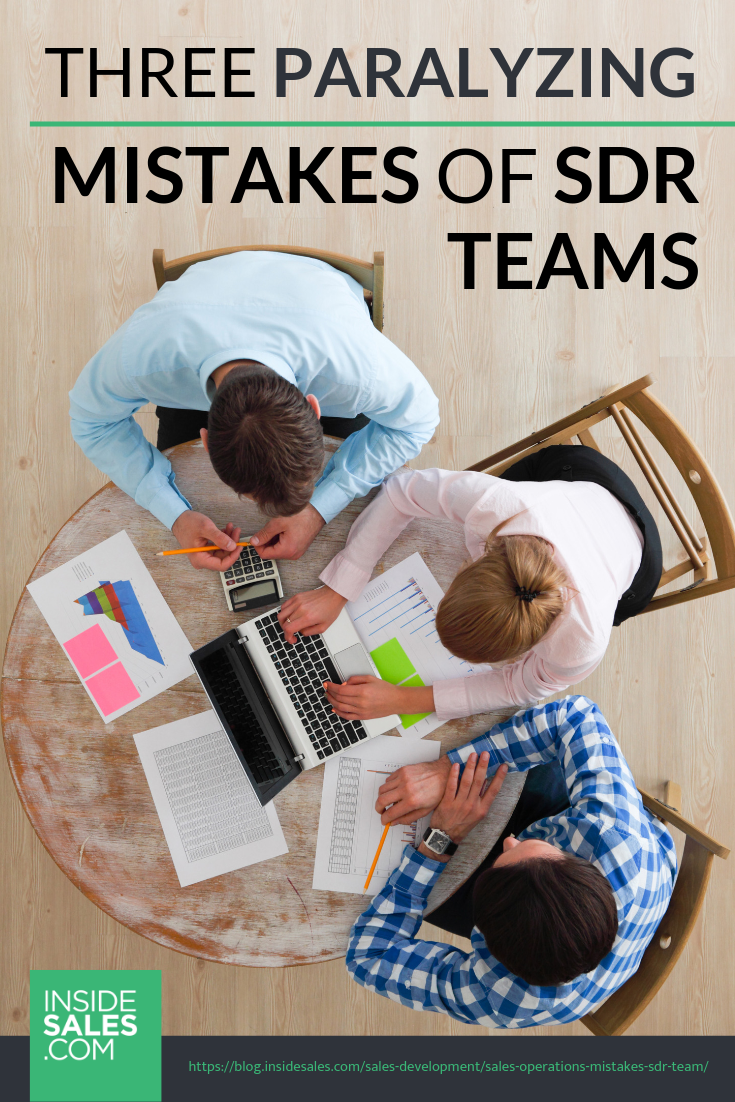Three Paralyzing Mistakes Of SDR Teams w/Becc Holland @G2
Xant Team
Becc Holland of G2 shares with us the top three sales operations mistakes that SDR teams commit and how to solve them. Keep reading to find out more.
RELATED: Top Tips for Sales Development
In this article:
- Discovering the SDR Industry’s Problems
- Sales Operations Problems: The Three Paralyzing Mistakes of SDR Teams
- Mistake #1: KPI Systems
- Mistake #2: Personalization
- Mistake #3: Requiring BANT Qualification
Sales Operations Mistakes to Avoid
Becc Holland is the Regional Vice President of Business Development for Enterprise West at G2. Her sales operations career started when she became an Account Executive straight out of college.
Then, she took “a step back” as a Sales Development Rep (SDR) because she wanted to learn more about tech. Before pushing for a tech product, she sought to learn more about the ecosystem by being an SDR.
In doing so, she “fell in love” with the idea of prospecting full time. Some people say it’s one of the most complex parts of the sales cycle, and Holland fell in love with the grit.
She wanted to find solutions for the age-old problems of sales development. She also shared with us that sales development itself is her number one passion inside and outside of work.
Discovering the SDR Industry’s Problems
When Holland was a frontline SDR raising her first team, she ran into a lot of conceptual issues. At first, she thought the problem was with her and their program because the theory was there but the execution wasn’t happening.
She then started to look at the situation in other companies, thinking that they already had it figured out. Yet she discovered that a lot of programs and businesses were running into the same sales operations issues when they deploy the old, parochial tactics.
Holland realized that the industry had problems. At the same time, she also knew that there must be solutions to these problems in sales operations.
In her perspective, if the industry can address its issues at the base level, then there’s a realistic shot to get it up and running again.
Sales Operations Mistakes: Three Common Paralyzing Mistakes Made by SDR Teams
Mistake #1: KPI Systems

Holland shared with us that this first item is the one that is most near and dear to her heart — the problem with KPI systems and how we measure sales reps.
She broke down this issue into the three most common sales operations mistakes she observed:
- Accrediting inbound to SDRs
- Round-robin inbound to the entire team. This means simply giving SDRs a target number of meetings to book.
- Giving a minimum qualification bar for potential buyers with no weighted systems in their title. This means putting the same value over any potential buyer that SDRs book, regardless of the position they’re holding. Some SDRs would go for the easiest person to book, even if someone else will be better for the business.
Inbound Sales Definition: In this methodology, salespeople prioritize the individual buyer’s needs, pain points, and interests. It doesn’t focus on closing the sale at the soonest time. Rather, inbound salespeople meet buyers at their current situation and guide them through the process of decision-making.
How to Solve the Problem in Accrediting Inbound and Round-Robining
To address these issues, Holland created three different KPI systems for inbound, outbound, and all bound sales.
Yet companies excuse their round-robin style by saying that inbound is their most important channel. They go on to reinforce this by saying that when their salespeople aren’t trained on outbound, inbound is their most lucrative channel.
That is why they make sure that they have as many people as possible working on it by giving it to each SDR.
One compromise that Holland found is to create a system where each inbound lead that an SDR processes subtracts from their quota. For instance, if they have a 10-meeting target, the quota would become 9.5 if they booked an inbound meeting.
Yet even this system can open another set of sales operations problems, such as:
- It doesn’t accurately measure the quality of an SDR.
- This system pays SDRs for something they didn’t really affect.
- It takes the heat off of outbound. The SDRs become complacent when you subtract on their quota, so they lose their hunger to book an outbound. If your SDR wants to become a real Account Executive, they need to learn how to do outbound sales.
Outbound Sales Definition: This is the methodology where the salesperson initiates an engagement with the potential buyer. Traditionally, salespeople make the first contact through cold calls or cold emails to leads.
How to Solve the Problem with the Weighting System
Holland talked about the two facets of the weighting system. She shared that for inbound-specific reps, she usually measures them 50% on speed to lead because that is something they can affect.
Then the other 50% of her criteria is the percentage of objectively-qualified leads that the SDR got into a meeting.
On the outbound front, Holland admitted that it baffles her why some businesses don’t care what kind of potential buyers their SDRs book for a meeting.
She let us in on the point-system she has going on for outbound reps. The top of the matrix is the potential size of the deal.
She also groups titles into three buckets:
- Vice Presidents and C-Level Executives
- Directors and Heads
- Senior Managers or Managers
This way, not all appointments are equal. She forces SDRs to think like an Account Executive — they would go for potential buyers with higher positions because they would earn more from it.
Holland’s compensation is more focused on points, and she associates each point with a different criteria of good and better leads.
Mistake #2: Personalization
The second sales operations problem that Holland saw had to do with personalization. As she said, most — if not all — programs send out templates and mass blasts.
In the best case scenario, they specify the template to the buyer persona. Based on her observation, SDR Departments are bereft of personalization across the board.
Yet Holland reiterated that this problem is not the fault of sales engagement vendors who help speed up the process. Rather, the problem lies on how salespeople are incorrectly using them.
RELATED: 7 Most Common Mistakes in Sales Process Mapping and How to Avoid Them
How to Solve the Problem with Personalization
We know that personalization trumps automation, so we asked Holland how sales development people can get into this mindset.
As a response, she shared with us the justifications behind mass blasts and buyer persona templates:
- From an operational perspective, sales is a numbers game.
- Leaders want to control the quality of messaging that the reps send out for consistency.
She also asked me if I personally responded to mass blasts, and if I thought our prospects are different than myself. I answered ‘no’ to both questions.
As Holland said, those should already point to the existence of a problem in sales operations. No one responds to mass blasts anymore because they’re convinced of two things:
- The message isn’t relevant and personalized to them, and that the person who sent it can’t help them. They don’t want to spend time figuring out if the sender can help them.
- The sender doesn’t respect them enough to spend time on an email. Instead, the sender is blasting low-hanging fruit emails to see if they can trigger their prospective buyers enough to set up a meeting.
The biggest problem with a mass blast is that it simply doesn’t work for both the sender and receiver. You always need to have a hook — whether through personalization or introducing how your business can benefit your potential buyer.
What Strategy Works Best for Cold Emails?
When Holland first taught her team how to write a personalized email properly, they received positive feedback from their early recipients.
Colleagues asked her what they were doing differently. The answer was sending out personalized messages each time.
She and her team were aggressive on thorough research instead of reaching a certain volume. From their experience, personalization is a great way to strike rapport with someone you don’t know.
As mass blasts don’t work on her and for her team, she recommends sales teams to write tailored emails each time.
Mistake #3: Requiring BANT Qualification

The last of the sales operations mistakes that Holland discussed is requiring SDRs to establish BANT qualification on inbound and outbound lines. Another facet of this is letting the Account Executive determine and validate the qualification of a prospect.
BANT Qualification Definition: This is a qualification method used to identify ideal prospects based on four criteria — budget, authority, needs, and timeline.
She believes that the gap between AEs and SDRs is process-related, and we haven’t done anything to correct it.
Holland started out as an AE, and she revealed that if an AE is struggling to hit quota, they’d find ways to make the situation work for themselves. They can invalidate the pipeline that came to them, or delay the verification on a lead’s qualification right before it closes. This would make it look like they converted 85% of the appointments given to them.
Leaving the AE to qualify based on the subjective, moving target criterion is not good for their department at large. It will also put SDRs in a position of uncertainty.
Should You Still Use BANT Qualification?
In terms of qualification methods, BANT is still the most widely used and accepted.
Holland cleared that she is not opposed to using qualification methods. Yet she reiterated that we are having our prospects buy our products in spite of us, not because of us.
It’s the AE’s job to build so much urgency within the buyer that they search around for budget. You don’t have to ask them how much they can spend.
You can take a concept like BANT and create your own, something that’s effective for your business. For instance, the company size and titles can put you in the right realm of qualification.
Sales Development’s goal is to send qualified appointments to Account Executives for them to close. That’s why after the SDR qualifies the lead, they should connect the lead to their AE.
It’s the AE’s job to establish BANT, drive urgency, and close the deal.
If you want to learn more about Becc Holland, visit her LinkedIn account and check out G2’s website. You can also join her free five-session series on how sales reps can do their jobs better by visiting this link.
Now that you know the sales operations mistakes your SDR team should avoid, it’s time to put good measures in place so you won’t commit them. Follow the sales tips we shared above to enjoy a thriving team of excellent salespeople.
Which of these mistakes do you find your own Sales Development team committing? Share your thoughts with us in the comments section below.
Up Next:
- 7 Ways to Boost Sales Effectiveness
- 7 Data-Backed Sales Best Practices [INFOGRAPHIC]
- 6 Effective Time Management Strategies from Sales Experts
